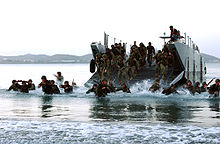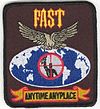- Marine Corps Security Force Regiment
-
Marine Corps Security Force Regiment 
unit logoActive 1920–present Country United States Branch United States Marine Corps Role Fleet security Garrison/HQ Naval Station Norfolk, Virginia Nickname Gunslingers Motto Deter, Detect, Defend Commanders Current
commanderCol Barton S. Sloat The Marine Corps Security Force Regiment is a dedicated security and anti-/counter-terrorism unit of the United States Marine Corps.[1][2] It provides security forces to guard high-value naval installations, most notably those containing nuclear vessels and weapons. It also provides Fleet Antiterrorism Security Teams (FAST) and Recapture Tactics Teams (RTT). Marines who complete Security Force training are assigned a secondary Military Occupational Specialty of 8152 (Marine Corps Security Force Guard), while instructors can earn 8153 (Marine Corps Security Force Cadre Trainer).
Contents
History
The unit was initially organized as the Marine Detachment, Naval Operation Base in 1920. It was redesignated as Marine Barracks, Norfolk in 1939. During World War II, Marines form the Norfolk Barracks provided security for several commands in the Tidewater area, including the Naval Station, Naval Air Station, and Naval Fuel Annex at Craney Island, and what is now Naval Amphibious Base Little Creek. In addition, the Barracks acted as the processing center for transient Marines on the East Coast. In addition to providing gate security for the Norfolk Naval Base Complex and a security force for a nearby Service Storage Facility, Barracks Marines also served as ceremonial troops and provided security at the headquarters of United States Atlantic Fleet and provided administrative support to Marines stationed in various Naval commands in Norfolk area.
The Barracks was redesignated as Marine Corps Security Force Battalion, Atlantic, on 1 April 1987, and exercised administrative control over security force companies and detachments afloat in the Atlantic region. The first FAST companies were established that same year to provide a more mobile force. On 16 December 1993, the Battalion was again redesignated as Marine Corps Security Force Battalion and assumed control of all security force companies and detachments globally. In 1998, numerous companies and detachments were deactivated due to force reductions and realignments; two FAST companies were established to take their place.
Marine Security Forces are not formally recognized as special forces. However, the unit traces lineage from (and was previously attached to) to the disbanded 4th Marine Expeditionary Brigade (Anti-Terrorism Brigade), the predecessor to Marine Corps Forces Special Operations Command, along with the Marine Special Operations Advisor Group, formally known as the Foreign Military Training Unit.
Units
- Active
- Headquarters, Naval Station Norfolk, Norfolk, Virginia
- Training Company, Naval Security Group Activity Chesapeake, Chesapeake, Virginia
- Battalion at Naval Base Kitsap, Bangor Trident Base, Washington
- Battalion at Naval Submarine Base Kings Bay, Kings Bay, Georgia
- Company at Guantanamo Bay Naval Base, Guantánamo Bay, Cuba
- Alpha FAST Company, Camp Allen, Norfolk, Virginia
- Bravo FAST Company, Naval Weapons Station Yorktown, Yorktown, Virginia
- Charlie FAST Company, Camp Allen, Norfolk, Virginia
- FAST Company Central, Naval Support Activity Bahrain, Manama, Bahrain
- FAST Company Europe, Naval Station Rota, Rota, Spain
- FAST Company Pacific, United States Fleet Activities Yokosuka, Yokosuka, Japan
- Inactive
- Naval Air Station Patuxent River, Lexington Park, Maryland
- Naval Air Station Keflavik, Keflavík, Iceland
- Naval Computer and Telecommunications Station Naples, Naples, Italy
- Detachment to Naval Support Activity Suda Bay, Crete, Greece
- Naval Activities United Kingdom, London, United Kingdom
- Naval Security Group Activity Sábana Seca, Puerto Rico
- Naval Station Subic Bay, Olongapo, Philippines
Fleet Antiterrorism Security Team
Fleet Antiterrorism Security Team 
Fleet Anti-Terrorism Security Team logoActive 1987–present Nickname FAST Company Motto Anytime, Anyplace Engagements USS Cole bombing, Operation Just Cause, American Embassy bombings in Kenya and Tanzania, Iraq, Afghanistan The Fleet Antiterrorism Security Team (FAST) is capable of rapidly deploying to immediately improve security at United States Government installations worldwide. FAST Marines are deployed at the discretion of the Chief of Naval Operations and the Commandant of the Marine Corps when the primary and auxiliary security forces of the Marines are unable to adequately respond to a security crisis.
Established in 1987, FAST companies provide a limited-duration, expeditionary security force to protect vital naval and national assets. FAST maintains forward-deployed platoons at various naval commands around the globe, and possesses U.S.-based alert forces capable of rapidly responding to unforeseen contingencies worldwide. Each FAST company is equipped and trains with some of the most state-of-the-art weaponry and currently consists of around 500 Marines.
FAST maintains a high degree of readiness in order to conduct these short-notice, limited-duration contingency operations, as seen in the port security mission following the attacks on the USS Cole (DDG-67) in October 2000 and the recent American Embassy reinforcements in Liberia and Haiti.
Recapture Tactics Team
Recapture Tactics Team Active 1987–present Nickname RTT, Close Quarters Battle Team, CQB Cowboys Motto Speed, Surprise, and Violence of Action The Recapture Tactics Team (RTT) is also known as the Security Force Close Quarters Battle Team. RTTs specialize in SWAT procedures without having to be military police special reaction team trained. RTT units are attached to Personal Reliability Commands around the globe located at select naval installations. Whereas FASTs deploy to areas in need of naval security operations, a RTT doesn't deploy because they are already placed in strategic locations.
RTTs receive the same training as FASTs, though FAST goes through training at the platoon level, and RTT goes through training at the squad level. RTT units attend the following training schools:
- Basic Security Guard (Marine Corps Security Guard Anti-Terrorism Training)
- High Risk Personnel also known as executive protection, similar to protective services detail, the military version of Federal Law Enforcement Training Center
- Close quarters combat
- Designated marksman
- Methods of Entry or MOE, (small unit demolition and door breaching tactics)
- Interservice Nonlethal Individual Weapons Instructor Course and other riot control techniques
However, this is not in the pipeline fashion, as it is with other specialty units. RTT receives the "on job training" needed after going to CQB school, before going to the others schools listed. Once formally trained, they receive the MOS 8154.
The Marine Corps Security Force Close Quarters Battle Team go to various installations as Mobile Training Teams to teach CQB to units such as Marine Corps Special Operations Command, Fleet Antiterrorism Security Team, military police special reaction teams, other military branches (both foreign and domestic), and law enforcement organizations (federal, state, and local).
Additional training and schools
Since Marine Corps Security Forces consists of Infantry Marines (other MOS's are needed to support MCSF), they are able to attend additional training and schools that the Fleet Marine Forces also attend. B-Billet Marines also attend Security Leaders Course, a 2 week school utilized strictly for MCSF. The following training and schools is open to all MCSF Marines (Marines who have completed BSG School), who have met the requirements set forth by the courses and their commands:
- Combat Hunter Course
- Tactical Site Exploitation Course
- HMMWV Driver Course
- BEAR/BEARCAT Driver Course
- Survival, Evasion, Resistance, Escape School Level B
- Pre-Scout Sniper Course (for Senior DM's in FAST, RTT, and Cadre units)
- Scout Sniper School (for Senior DM's in FAST, RTT, and Cadre units)
- Infantry Squad Leaders Course
- Infantry Unit Leaders Course
- Martial Arts Instructor Course
- Martial Arts Instructor Trainer School
- Corporals Course
- Sergeants Course
- Staff Academy
- Mountain Survival Course
- Mountain Leaders Course
- HRST Master Course
- Marine Combat Instructor of Water Surival School
- Formal Marksmanship Training Coaches Course
- Formal Marksmanship Training Trainers Course
- Advanced Urban Combat (FAST Company only, equivilent to Close Quarters Battle School)
- Urban Leaders Course (MOUT Instructor Course, Convoy Course, Urban Shooting Skills Course, Foreign Weapons Course)
These schools help prepare the MCSF Marine (FAST, RTT, PRP, 8th & I, CADRE) to be better equipped with not only their current jobs, but set them up for success when they rotate to the Fleet Marine Forces. Not all MCSF Marines are given the option to attend these schools, they must prove themselves capable and therefore earn the right to go.
After Marine Corps Security Forces
MCSF Marines who have completed a successful A-Billet or B-Billet within their assigned Specialty MOS have the option of rotating back to the Fleet Marine Forces (Infantryman, Scout Sniper, Platoon Sergeant, Platoon Commander). B-Billet MCSF Marine have the option to have their orders modified to try and complete the MARSOC ASPOC and A&S. If completed, they can attend MARSOC ITC. If unable to complete ASPOC, A&S or ITC, will cause the MCSF Marine to be rotated back to the Fleet Marine Forces under their Primary MOS.
See also
References
 This article incorporates public domain material from websites or documents of the United States Marine Corps.
This article incorporates public domain material from websites or documents of the United States Marine Corps.
- profile at GlobalSecurity.org
- MCO P1326.6D SELECTING, SCREENING, AND PREPARING ENLISTED MARINES FOR SPECIAL DUTY ASSIGNMENTS AND INDEPENDENT DUTIES
- Marine Corps Enlisted Job Descriptions: MOS 8154—Marine Corps Security Force (MCSF) Close Quarters Battle (CQB) Team on About.com
- Special Operations.Com's USMC Fleet Antiterrorism Security Team (FAST) page
- FAST Company entry at GlobalSecurity.org
- Rowe, Charles W. "F.A.S.T. is the Way to Go!" The Gun Digest Book of Assault Weapons, 3rd Edition. Jack Lewis, ed. Northbrook, Illinois: DBI Books, 1993. ISBN 0-87349-139-4.
External links
Categories:- Regiments of the United States Marine Corps
Wikimedia Foundation. 2010.




